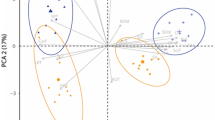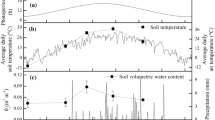Summary
Piper auritum (H.B. & K.), a pioneer tree restricted to open sites and Piper hispidum (Swartz), a shrub common in sites ranging from recent clearings to shaded understory, both adjust photosynthetic characteristics in response to light availability during growth. The sensitivity of photosynthetic capacity to light availability during growth was indistinguishable for the two species growing in their natural habitat. Photosynthetic capacity was strongly correlated with leaf nitrogen in both species, and the relationship was similar between species. Dark respiration and leaf specific mass were more sensitive to light during growth in P. hispidum, the species with the broad habitat ange, than in P. auritum. In general, similarities between the species were more striking than differences between them. The differences in dark respiration could have important implications for carbon balance. The difference in the responsiveness of leaf specific mass to light indicates that the broad-ranging species maintains access to modes of response little utilized by the open-site specialist. We did not and, in the gas exchange characteristics, any evidence that the open site specialist is better suited than the generalist to high-light sites.
Similar content being viewed by others
References
Anderson MC (1964) Studies of the woodland light climate. 1. The photographic computation of light conditions. J Ecol 52:27–41
Ashton PS (1978) Crown characteristics of tropical trees. In: Tomlinson PB, Zimmermann MH (eds) Tropical trees as living systems. Cambridge University Press, Cambridge, pp 591–616
Bazzaz FA (1979) The physiological ecology of plant succession. Ann Rev Ecol Syst 10:351–371
Bazzaz FA, Carlson RW (1982) Photosynthetic acclimation to variability in the light environment of early and late successional plants. Oecologia (Berlin) 54:313–316
Björkman O (1981) Responses to different quantum flux densities. In: Lange OL, Nobel PS, Osmond CB, Ziegler H (eds) Encyclopedia of plant physiology, Vol 12A. Plant physiological ecology I. Springer, Berlin Heidelberg, New York, pp 57–107
Björkman O, Holmgren P (1963) Adaptability of the photosynthetic apparatus to light intensity in ecotypes from exposed and shaded habitats. Physiol Planta 16:889–914
Brooks A, Farquhar GD (1986) Effect of temperature on the CO2/O2 specificity of ribulose-1,5-bisphosphate carboxylase/oxygenase and the rate of respiration in the light: Estimates from gas exchange measurements on spinach. Planta 165:397–406
Burger WC (1972) Evolutionary trends in the Central American species of Piper (Piperaceae). Brittonia 24:356–362
Caemmerer S von, Farquhar GD (1981) Some relationships between the biochemistry of photosynthesis and the gas exchange of leaves. Planta 153:376–387
Caemmerer S von, Farquhar GD (1984) Effects of partial defoliation, changes of irradiance during growth, short-term water stress and growth at enhanced p(CO2) on the photosynthetic capacity of leaves of Phaseolus vulgaris L. Planta 160:320–329
Chapin FS III, Bloom AJ, Field CB, Waring RH (1987) Plant responses to multiple environmental factors. Bioscience 37:49–57
Chazdon RL (1985) Leaf display, canopy structure, and light interception of two understory palm species. Am J Bot 72:1493–1502
Chazdon RL, Fetcher N (1984) Photosynthetic light environments in a lowland tropical rainforest of Costa Rica. J Ecol 72:553–564
Chazdon RL, Pearcy RW (1986) Photosynthetic responses to light variation in rainforest species II. Carbon gain and photosynthetic efficiency during sunflecks. Oecologia (Berlin) 69:524–531
Chiariello N (1984) Leaf energy balance in the wet lowland tropics. In: Medina E, Mooney HA, Vazquez-Yanes C (eds) Physiological ecology of plants of the wet tropics. Junk, The Hague, pp 85–98
Clausen J, Keck DD, Heisey WM (1940) Experimental studies of the nature of species I. Effect of varied environments on wester North American Plants. Carnegie Inst Washington Pub No 520, Washington, 452 pp
Ehleringer JR, Werk KS (1986) Modifications of solar radiation absorption patterns and implications for carbon gain at the leaf level. In: Givnish TJ (ed) On the economy of plant form and function. Cambridge Univ Press, Cambridge, pp 57–82
Estrada A, Coates-Estrada R, Martinez-Ramos M (1985) Le estacion de biologia tropical Los Tuxtlas: Un recurso para el estudio y conservacion de las selvas del tropico humedo. In: Gomez-Pompa A, Del Amo S (eds) Investigaciones sobre la regeneracion de selvas altas en Veracruz, Mexico. Vol II. Editorial Alhambra Mexicana, Mexico, pp 379–393
Evans JR (1983) Nitrogen and photosynthesis in the flag leaf of wheat (Triticum aestivum L.). Plant Physiol 72:297–302
Fetcher N, Oberbauer SF, Rojas G, Strain BR (1986) Effects of light regime on photosynthesis and growth in seedlings of tropical rainforest trees. Rev Biol Trop (San Jose) (in press)
Field C, Mooney HA (1986) The photosynthesis-nitrogen relationship in wild plants. In: Givnish TJ (ed) On the economy of plant form and function. Cambridge Univ Press, Cambridge pp 25–55
Field C, Berry JA, Mooney HA (1982) A portable system for measuring carbon dioxide and water vapour exchange of leaves. Plant Cell Env 5:179–186
Fleming TH (1985) Coexistence of five species of sympatric Piper (Piperaceae) species in a dry tropical forest. Ecology 66:688–700
Gauhl E (1976) Photosynthetic response to varying light intensity in ecotypes of Solanum dulcamara L. from exposed and shaded habitats. Oecologia (Berlin) 22:275–286
Gauhl E (1979) Sun and shade ecotypes of Solanum dulcamara L.: Photosynthetic light dependence characteristics in relation to mild water stress. Oecologia (Berlin) 39:61–70
Gomez-Pompa A (1971) Posible papel de la vegetacion secundaria en la evlucion de la flora tropical. Biotropica 3:125–135
Gulmon SL, Chu CC (1981) The effects of light and nitrogen on photosynthesis, leaf characteristics, and dry matter allocation in the chaparral shrub, Diplacus aurantiacus. Oecologia (Berlin) 49:207–212
Heisey WM, Nobs MA, Björkman O (1971) Experimental studies on the nature of species V. Biosystematics, genetics, and physiological ecology of the Erytharanthe section of Mimulus. Carnegie Inst Washington Pub No 628, Washington, 213 pp
Heywood JS, Fleming TH (1986) Patterns of allozyme variation in three Costa Rican species of Piper. Biotropica 18:208–213
Ibarra G (1985) Tesis Professional, Universidad Nacional Autonoma de Mexico, Mexico
Isaac RA, Johnson WC (1976) Determination of total nitrogen in plant tissue, using a block digestor. J Assoc Anal Chem 59:98–100
MacArthur RH, Pianka ER (1966) On optimal use of a patchy environment. Am Nat 100:603–609
Marquis RJ (1985) Leaf herbivores decrease fitness of a tropical plant. Science 226:537–539
Mott K, Jensen R, Berry JA (1984) Photosynthesis and ribulose-1,5-bisphosphate concentrations in intact leaves of Xanthium strumarium L. Plant Physiol 76:968–971
Nobel PS, Walker DB (1985) Structure of leaf photosynthetic tissue. In: J Barber, NR Baker (eds) Topics in photosynthesis, vol 6. Photosynthetic mechanisms and the environment. Elsevier, Amsterdam, pp 501–536
Núñez-Farfán J, Dirzo R (1985) Herbivoria y sucesion en una selva alta perennifolia. In: Gomez-Pompa A, Del Amo S (eds) Investigaciones sobre la regeneracion de selvas altas en Veracruz, Mexico. Vol II. Editorial Alhambra Mexicana, Mexico, pp 313–332
Oberbauer SF, Strain BR (1984) Photosynthesis and successional status of Costa Rican rain forest trees. Photosyn Res 5:1–5
Osmond CB (1983) Interactions between irradiance, nitrogen nutrition, and water stress in the sun-shade responses of Solanum dulcamara. Oecologia (Berlin) 57:316–321
Orozco-Segovia ADL (1986) Fisiología ecológia del photoblastismo en semillas de cuatro especies del género Piper L. PhD Thesis. Universidad Nacional Autonoma de México, Mexico 123 pp
Rawson HM, Constable GA (1980) Carbon production of sunflower cultivars in field and controlled environments. I Photosynthesis of leaves, stems, and heads. Aust J Plant Physiol 7:555–573
Richards PW (1952) The tropical rain forest: An ecological study. Cambridge University Press, Cambridge, p 450
Rundel PW, Becker PF (1987) Seasonal plant water relations and vegetative phenology in the tropical forest understory of Barro Colorado Island, Panama, Rev Biol Trop (San Jose) (in press)
Rzedowski J (1978) Vegetación de México. Editorial Limusa, Mexico, 432 pp
Sokal RR, Rohlf FJ (1981) Biometry. Freeman, San Francisco, 766 pp
Tinoco-Ojanguren C, Vazquez-Yanes C (1983) Diferencias en poblaciones de Piper hispidum bajo condiciones de luz contrastante en una selva alta perennifolia. Biotica 8:281–293
Vazquez-Yanes C (1976) Estudios sobre ecophysiologia de la germinacion en una zona calido-humeda de Mexico. In: Gomez-Pompa A, Vazquez-Yanes C, Del Amo S, Butanda A (eds) Regeneracion de selvas. Editorial Continental, Mexico, pp 279–381
Vazquez-Yanes C, Orozco-Segovia A (1982) Germination of seeds of a tropical rain forest shrub, Piper hispidum Sw. (Piperaceae) under different light qualities. Phyton 42:143–149
Vazquez-Yanes C, Smith H (1982) Phytochrome control of seed germination in the tropical rain forest pioneer trees Cecropia obtusifolia and Piper auritum and its ecological significance. New Phytol 92:477–485
Vitousek PM, Denslow JS (1987) Nutrient dynamics in treefall gaps in a lowland tropical rainforest. J Ecol (in press)
Author information
Authors and Affiliations
Additional information
This CIW DPB publication number 962
Rights and permissions
About this article
Cite this article
Walters, M.B., Field, C.B. Photosynthetic light acclimation in two rainforest Piper species with different ecological amplitudes. Oecologia 72, 449–456 (1987). https://doi.org/10.1007/BF00377578
Received:
Issue Date:
DOI: https://doi.org/10.1007/BF00377578




